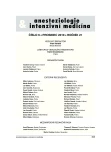Comparison of patient satisfaction after general and regional anaesthesia in total hip and knee replacement surgery
Authors:
Fořtová Magdaléna; Šnajdárková Kateřina; Štorek Ludvík; Melicharová Olga; Hájková Tereza; Skoupá Markéta
Authors place of work:
Anesteziologicko-resuscitační oddělení, Pardubická krajská nemocnice, a. s.
Published in the journal:
Anest. intenziv. Med., 21, 2010, č. 6, s. 311-316
Category:
Anesteziologie - Původní práce
Summary
Objective:
The aim of the study was comparing patient satisfaction and pain after general vs. regional anaesthesia in total hip and knee replacement surgery.
Design:
A prospective, comparative study.
Setting:
Department of Anesthesiology and Resuscitation, Regional Hospital.
Materials and methods:
All the patients who underwent total hip or knee replacement in general (GA) vs. combined epidural/spinal anaesthesia (EA/SA) in a one-year period were included in the study. The patients evaluated their satisfaction and pain relief at 6, 24 and 48 hours after surgery.
Results:
We evaluated 127 patients after total hip or knee replacement under general vs. epidural/ spinal anaesthesia. Patient satisfaction was significantly higher in the EA/SA vs. GA group at 6, 24 and 48 hours. Pain was significantly lower in the EA/SA vs. GA group at 6 and 24 hours. At 48 hours there were no differences between the two groups.
Conclusion:
We confirmed the hypothesis of higher patient satisfaction and better analgesia after EA/SA compared with general anaesthesia.
Keywords:
general – regional anaesthesia – total hip replacement – total knee replacement – satisfaction – analgesia
Zdroje
1. Heidegger, T., Saal, D., Nuebling, M. Patient satisfaction with anesthesia care: what is patient satisfaction, how should it be measured, and what is the evidence for assuring high patient satisfaction? Best Pract. Res. Anaesthesiol., 2006, 20 (2). p. 331–346.
2. Wolowicka, L., Trojanowska, I., Barthowska-Sniatkowska, A., Buchwald, E. Patient satisfaction with anesthesia as a measure of quality of anesthesia care. Folia Med. Cracov., 2001, 42 (4), p. 219–226.
3. Le May, S., Hardy, J. F., Taillefer, M. C., Dupuis, G. Patient satisfaction with anesthesia services. Can. J. Anaesth., 2001, 48 (2), p. 153–161
4. Caljouw, M. A., van Beuzekom, M., Boer, F. Patient´s satisfaction with periopeative care: development, validation and application of a questionnaire. Br. J. Anaesth., 2008, 100 (4), p. 637–644.
5. Capuzzo, M., Gilli, G., Paparella, L., Gritti, G., Gambi, D., Bianconi, M., Giunta, F., Buccoliero, C., Alvisi, R. Factors predictive of patient satisfaction with anesthesia. Anesth. Analg., 2007, 105 (2), p. 435–442.
6. Stober, H. D., Mencke, T. General anesthesia or spinal anesthesia for hip prosthesis replacement? Studie of acceptance of both procedures by patiens. Anaesthesiol. Reanimation, 1999, 24 (6), p. 151–156.
7. Standl, T., Eckert, S., Schulteam Esch, J. Postoperative complaints after spinal and thiopentone-isoflurane anaesthesia in patients undergoing orthopaedic surgery. Spinal versus general anaesthesia. Acta Anaesthesiol Scand., 1996, 40 (2), p. 222–226.
8. Mauermann, W. J., Shilling, A. M., Zuo, Z. A comparison of neuraxial block versus general anesthesia for elective total hip replacement: a meta analysis. Anesth. Analg., 2006, 103 (4), p. 1018–1025.
9. Eberhart, L. H., Mauch, M., Morin, A. M., Wulf, H., Geldner, G. Impact of multimodal anti-emetic prophylaxis on patien satisfaction in high risk patients for postoperative nausea and vomiting. Anaesthesia, 2002, 57 (10), p. 1022–1027.
10. Thierbach, A., Fichtner, K., Kugler, A., Dick, W. Patient´s emotional satisfaction with anaesthetic care. Anaesthesiol. Intensivmed. Notfallmed. Schmerzther, 2003, 38 (2), p. 85–93.
11. Auquier, P., Pernoud, N., Bruder, N., Simeoni, M. C., Aufffray, J. P., Colavolpe, C., Francois, G., Gouin, F., Manelli, J. C., Sapin, C., Blache, J. L. Development and validation of a perioperative satisfaction questionnaire. Anesthesiology, 2005, 102 (6), p. 1116–1123.
12. Capuzzo, M., Alvisi, R. Is it possible measure and improve patient satisfaction with anesthesia? Anesthesiol. Clin., 2008, 26 (4), p. 613–626.
13. Gonano, C., Leitgeb, U., Sitzwohl, C., Ihra, G., Wiestabl, C., Kettner, S. C. Spinal versus general anesthesia for orthopedic surgery? Anesthesia drug and supply costs. Anest. Analg., 2006, 102 (2), p. 524–529.
14. Indelli, P. F., Grant, S. A., Nielsen, K., Vail, T. P. Regional anesthesia in hip surgery. Clin. Orthop. Relat. Res., 2005, 441, p. 250–255.
Štítky
Anesteziologie a resuscitace Intenzivní medicínaČlánek vyšel v časopise
Anesteziologie a intenzivní medicína

2010 Číslo 6
- Léčba akutní pooperační bolesti z pohledu ortopeda
- Perorální antivirotika jako vysoce efektivní nástroj prevence hospitalizací kvůli COVID-19 − otázky a odpovědi pro praxi
- Neodolpasse je bezpečný přípravek v krátkodobé léčbě bolesti
- Prokalcitonin: marker vhodný pro diagnostiku sepse i hodnocení antimikrobiální léčby
- Kombinace orfenadrinu a diklofenaku v infuzní terapii bolesti a svalových spasmů
Nejčtenější v tomto čísle
- Septický šok při fatálně probíhající stafylokokové pneumonii: význam Pantonova-Valentinova leukocidinu – kazuistika
- Trombocyty v sepsi
- Srovnání spokojenosti pacientů po celkové a regionální anestezii u operačních náhrad kyčelních a kolenních kloubů
- Katétrová vysokofrekvenčná ventilácia pľúc pri tracheostómii podľa Fantoniho
